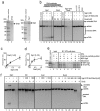DNA end resection by Dna2-Sgs1-RPA and its stimulation by Top3-Rmi1 and Mre11-Rad50-Xrs2
- PMID: 20811461
- PMCID: PMC3089589
- DOI: 10.1038/nature09355
DNA end resection by Dna2-Sgs1-RPA and its stimulation by Top3-Rmi1 and Mre11-Rad50-Xrs2
Abstract
The repair of DNA double-strand breaks (DSBs) by homologous recombination requires processing of broken ends. For repair to start, the DSB must first be resected to generate a 3'-single-stranded DNA (ssDNA) overhang, which becomes a substrate for the DNA strand exchange protein, Rad51 (ref. 1). Genetic studies have implicated a multitude of proteins in the process, including helicases, nucleases and topoisomerases. Here we biochemically reconstitute elements of the resection process and reveal that it requires the nuclease Dna2, the RecQ-family helicase Sgs1 and the ssDNA-binding protein replication protein-A (RPA). We establish that Dna2, Sgs1 and RPA constitute a minimal protein complex capable of DNA resection in vitro. Sgs1 helicase unwinds the DNA to produce an intermediate that is digested by Dna2, and RPA stimulates DNA unwinding by Sgs1 in a species-specific manner. Interestingly, RPA is also required both to direct Dna2 nucleolytic activity to the 5'-terminated strand of the DNA break and to inhibit 3' to 5' degradation by Dna2, actions that generate and protect the 3'-ssDNA overhang, respectively. In addition to this core machinery, we establish that both the topoisomerase 3 (Top3) and Rmi1 complex and the Mre11-Rad50-Xrs2 complex (MRX) have important roles as stimulatory components. Stimulation of end resection by the Top3-Rmi1 heterodimer and the MRX proteins is by complex formation with Sgs1 (refs 5, 6), which unexpectedly stimulates DNA unwinding. We suggest that Top3-Rmi1 and MRX are important for recruitment of the Sgs1-Dna2 complex to DSBs. Our experiments provide a mechanistic framework for understanding the initial steps of recombinational DNA repair in eukaryotes.
Figures




References
-
- Krogh BO, Symington LS. Recombination proteins in yeast. Annu. Rev. Genet. 2004;38:233–271. - PubMed
Publication types
MeSH terms
Substances
Grants and funding
LinkOut - more resources
Full Text Sources
Other Literature Sources
Molecular Biology Databases
Research Materials
Miscellaneous

